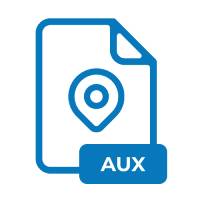.AUX File Extension

LaTeX Auxiliary File
| Developer | Microsoft |
| Popularity | |
| Category | Settings Files |
| Format | .AUX |
| Cross Platform | Update Soon |
What is an AUX file?
The .AUX file is used by TeX and LaTeX compilers to store auxiliary information generated during the typesetting process. It contains data such as cross-references, citations, and other information needed for correct compilation and typesetting of documents.
More Information.
.AUX files were designed to facilitate the accurate typesetting of documents that include citations, cross-references, table of contents, and other complex structures that require multiple passes of compilation to resolve dependencies correctly.
Origin Of This File.
TeX, developed by Donald Knuth in the late 1970s, introduced .AUX files as part of its system to manage complex typesetting tasks. LaTeX, which is built on top of TeX, also uses .AUX files extensively.
File Structure Technical Specification.
Content: The content of .AUX files typically includes references to labels, citations, and other document-specific data.
Format: It is a plaintext file with structured data readable by TeX and LaTeX compilers.
Location: .AUX files are usually located in the same directory as the main .tex file.
How to Convert the File?
Windows
- Open and Edit: Use any text editor like Notepad, Notepad++, or specialized LaTeX editors (e.g., TeXworks, TeXstudio).
- Backup: Make copies of
.AUXfiles as needed for version control or recovery purposes. - Cleaning: If issues arise with
.AUXfiles (e.g., corruption), you may delete them, as TeX and LaTeX will regenerate them during the next compilation.
Linux
- Text Editors: Use terminal-based editors like Vim or GUI editors such as TeXworks, TeXstudio, or Kile.
- Commands: Use command-line tools to manipulate or view
.AUXfiles (e.g.,cat,vim,nano).
macOS
- TextEdit: Use TextEdit for basic viewing and editing.
- LaTeX Editors: TeXShop is a popular choice for macOS users for LaTeX editing and managing
.AUXfiles.
Android
- Apps: Use specialized LaTeX editors like VerbTeX, which can handle
.AUXfiles indirectly through their management of LaTeX projects.
iOS
- Apps: Use LaTeX-specific apps like TeX Writer, which manage LaTeX projects and their associated
.AUXfiles.
Other Platforms
- Cross-Platform Tools: Use online LaTeX editors or platform-independent text editors that support LaTeX syntax highlighting and management of
.AUXfiles.
Advantages And Disadvantages.
Advantages:
- Essential for accurate document typesetting in TeX and LaTeX.
- Stores critical information required for multiple-pass compilation.
Disadvantages:
- Can become corrupted if editing or compilation processes are interrupted.
- Not directly readable as a final document format; requires interpretation by TeX or LaTeX engines.
How to Open AUX?
Open In Windows
.AUX files can be opened using any text editor such as Notepad, Notepad++, or specialized LaTeX editors like TeXShop or TeXworks.
Open In Linux
Use text editors like Vim, Emacs, or GUI-based editors such as TeXstudio or Kile.
Open In MAC
TextEdit or specific LaTeX editors like TeXShop are suitable for opening .AUX files.
Open In Android
Specialized apps like TeX Writer (iOS) or VerbTeX (Android) can handle .AUX files, though they are primarily used for editing .tex files.
Open In IOS
Specialized apps like TeX Writer (iOS) or VerbTeX (Android) can handle .AUX files, though they are primarily used for editing .tex files.
Open in Others
Any system capable of running a TeX or LaTeX distribution can handle .AUX files using appropriate text editors or LaTeX IDEs.












